(RxWiki News) Sometimes, treating a patient may lead to worse outcomes than if the patient was not treated. When it comes to tangled vessels in the brain, this may be one of those times.
People with arteriovenous malformations (AVM) were less likely to have a stroke or die when they were treated conservatively rather than aggressively treated, a new study has found.
AVM is an abnormal connection between arteries and veins. The condition occurs in about 1 in 2,000 people. Typically, patients are born with the condition, but may only learn they have AVM when they have an x-ray or start having symptoms, such as headaches or seizures.
"Always discuss treatment options with your doctor."
AVM can rupture at any time, leading to bleeding in the brain and possibly stroke or death. There is a 1 percent annual risk of bleeding in the brain for those with AVM.
This study was led by Rustam Al-Shahi Salman, PhD, of the University of Edinburgh in Scotland.
The study included 204 residents of Scotland who were enrolled from 1993-2003 or 2006-2010.
In previous studies, patients with AVM did better if their symptoms, such as seizures or headaches, were controlled with medication or other means, rather than having a surgical procedure to eliminate the AVM. The researchers wanted to know if this was true for a lengthy period of time.
All of the patients were 16 years of age and older, and all had AVM with associated weakened artery walls, making them prone to bursting. Of the 204 patients, 103 were treated.
Those in the treatment group had either endovascular embolization (a procedure in which a vessel is blocked off with glue or coils), neurosurgical excision (surgical removal of the malformed venous structure) or stereotactic radiosurgery (high-powered radiation). In some cases, these patients had more than one procedure.
During 12 years of follow-up, there were 14 events (stroke or death) in the conservative group (those who did not undergo any procedure to treat AVM) versus 38 in the treatment group.
The authors noted that that there were some problems with their study, including that those patients who were in the treatment group tended to be younger, experienced more seizures and had smaller malformations than people in the conservative/no procedure group. Patients were selected for treatment and not randomly assigned to either group.
More studies with even longer follow-up are needed to confirm the results of this study, the authors suggested.
It may be hard to convince people who have AVMs to just wait, Dr. Salman noted in a press release. "Many patients feel that living with AVM is like living with a time bomb in your head that could explode at any time. Patients and their doctors face difficult choices when deciding whether or not to pursue treatment, “ he said.
Still, he said, "We have found that, for most people whose AVM has not caused a bleed, the risks of treatment exceed the risks of leaving it alone over 12 years."
While several studies have indicated similar findings, William Ashley, Jr., MD, PhD, a neurosurgeon at Loyola University Medical Center in Chicago, said that there are a few topics this study's authors failed to address.
For one, these authors did not discuss the different success rates they may have had with each procedure. For another, the size of the patient's AVM was not mentioned. In some patients Dr. Ashley has seen, AVM has grown considerably over time when left untreated.
"Many patients have significant impact of AMV," Dr. Ashley noted. This impact can include cognitive issues and headaches. "Often enough they do grow, we have to continue to watch them carefully," he said.
While the study "helps to fuel the discussion," there are no clear answers as to what should be done, Dr. Ashley noted, and each person with AVM must be treated on a case by case basis. Those who are not treated with any procedure need to be followed carefully, he added.
This study appeared in the April 23/30 edition of JAMA.
One of the study's authors disclosed receiving a grant or personal fees during the course of the study. There were no other disclosures.







